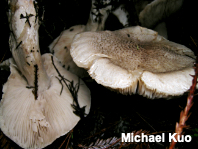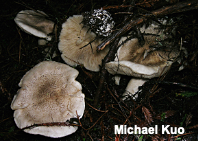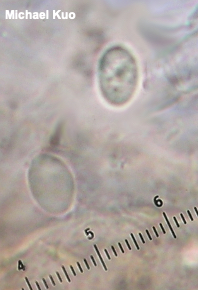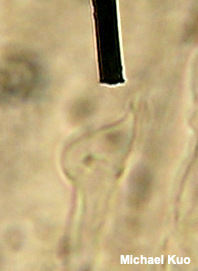| Major Groups > Gilled Mushrooms > Pale-Spored > Tricholoma > Tricholoma pardinum |

|
Tricholoma pardinum [ Basidiomycota > Agaricales > Tricholomataceae > Tricholoma . . . ] by Michael Kuo Tricholoma pardinum is a large, attractive, European Tricholoma found under conifers. In North America the name is applied to a northern and montane species that shares physical features with the European species and also appears under conifers—and to a hardwood-associated species in coastal California that may or may not be the same. The overall appearance, mealy odor, and fairly large size make Tricholoma pardinum very similar to Tricholoma venenatum, which is a slightly paler, somewhat less scaly, hardwood-loving species, and to Tricholoma smithii, a recently described conifer-associated species from the western mountains that may account for some of the montane reports of Tricholoma pardinum. Tricholoma tigrinum and Tricholoma pardalotum are synonyms. Description: Ecology: Mycorrhizal with conifers in northern and montane areas, but associated with tanoak, madrone, and live oak on the West Coast; growing alone, scattered or gregariously; fall (winter on the West Coast); widely distributed in northern and montane North America, and on the West Coast. The illustrated and described collection is from California. Cap: 4–15 cm; broadly convex, flat, or broadly bell-shaped; dry; grayish brown when unexpanded, but soon becoming whitish to pale grayish brown underneath small, regularly scattered, gray-brown to nearly black scales. Gills: Attached to the stem by a notch; close; whitish to dull grayish; short-gills frequent. Stem: 3–12 cm long; 1–3.5 cm thick; equal or somewhat swollen below; covered with silky appressed fibers; dry; white; sometimes discoloring brownish where handled; basal mycelium white. Flesh: Thick and firm; white to pale grayish; not changing when sliced. Odor and Taste: Mealy. Spore Print: White. Chemical Reactions: KOH negative on cap surface. Microscopic Features: Spores 7–9 x 4–5 µm; ellipsoid; smooth; hyaline in KOH; inamyloid. Basidia 4-sterigmate. Cheilocystidia, pleurocystidia not found. Pileipellis a cutis of cylindric elements 2.5–7.5 µm wide; hyaline to brownish in KOH. Clamp connections present. REFERENCES: Quélet, 1873. (Ovrebo, 1973; Smith, 1975; Smith, Smith & Weber, 1979; Ovrebo, 1980; Arora, 1986; States, 1990; Breitenbach & Kränzlin, 1991; Phillips, 1991/2005; Lincoff, 1992; Shanks, 1994; Barron, 1999; Miller & Miller, 2006; Trudell & Ammirati, 2009; Bessette et al., 2013; Christensen & Heilmann-Clausen, 2013; Desjardin, Wood & Stevens, 2015; Siegel & Schwarz, 2016; Baroni, 2017; Heilmann-Clausen et al., 2017; Ovrebo & Hughes, 2018.) Herb. Kuo 01140602. This website contains no information about the edibility or toxicity of mushrooms. |
© MushroomExpert.Com |
|
Cite this page as: Kuo, M. (2019, January). Tricholoma pardinum. Retrieved from the MushroomExpert.Com Web site: http://www.mushroomexpert.com/tricholoma_pardinum.html |



